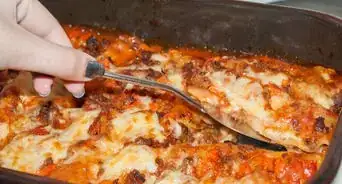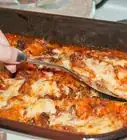This article was co-authored by Ollie George Cigliano. Ollie George Cigliano is a Private Chef, Food Educator, and Owner of Ollie George Cooks, based in Long Beach, California. With over 20 years of experience, she specializes in utilizing fresh, fun ingredients and mixing traditional and innovative cooking techniques. Ollie George holds a BA in Comparative Literature from The University of California, Berkeley, and a Nutrition and Healthy Living Certificate from eCornell University.
There are 9 references cited in this article, which can be found at the bottom of the page.
wikiHow marks an article as reader-approved once it receives enough positive feedback. This article has 12 testimonials from our readers, earning it our reader-approved status.
This article has been viewed 677,779 times.
Freezing homemade lasagna is a great way to have ready-made meals on hand for nights when it's all you can do to turn the oven on and heat up dinner. When you make lasagna and freeze it for later, you'll have a homemade, healthy meal on hand whenever you need it. You can freeze lasagna baked or unbaked, but you'll need to thaw it overnight before cooking it to serve. See Step 1 to learn how to freeze lasagna so that it stays fresh-tasting.
Steps
Freezing the Lasagna
-
1Make a freezer-friendly lasagna recipe. Some ingredients taste better than others when they're reheated after being frozen. Most lasagna recipes that call for fresh ingredients will be just fine after freezing, whether you freeze them unbaked or baked. However, if the recipe uses items that have already been frozen and thawed once, it's best not to freeze and thaw them twice. This increases the chance that the food could be contaminated by bacteria.[1]
- For example, don't plan on freezing lasagna made with sausage or ground beef that was previously frozen. Instead, use fresh meat or leave it out completely.[2]
- Food that is frozen and thawed more than once also suffers when it comes to flavor and texture. Choosing a recipe that calls for fresh ingredients will result in the best-tasting lasagna.
- If your favorite lasagna recipe calls for a frozen ingredient, the final dish usually won't be too affected by substituting the fresh version instead. For example, instead of using frozen mushrooms, just use fresh. In most cases you will have needed to thaw them anyway.[3]
-
2Assemble the lasagna in a dish that can be frozen. Stack the lasagna as follows for at least 3 layers: sauce, pasta, meat, cheese. Look for a "freezer-proof" label or be certain that the dish can be frozen as well as used for baking. Most glass or ceramic casserole dishes are fine for this purpose.[4]
- Avoid using an aluminum pan for long-term storage of lasagna. The food might end up picking up a tinny taste.
- If you don't have a dish that can be used to both bake and freeze lasagna, you can bake it one dish and freeze it in a freezer-safe food storage container.
Advertisement -
3Decide whether to bake it first. Lasagna that has been baked before freezing will still taste great after it has been reheated. Lasagna that has been assembled and frozen before baking is delicious, too. Use whichever method is most convenient for you, since the final texture and taste of the dish won't be too affected either way.
- You might decide to freeze pre-baked lasagna if you have leftovers after making a big batch.
- If you'd rather freeze it before baking, consider making two lasagnas next time you're having lasagna for dinner. You can bake one and freeze the other to eat later.
-
4Bring the lasagna to room temperature. If you want to freeze baked lasagna, it's necessary to make sure it has cooled entirely before you freeze it. Otherwise, the texture of the dish won't be as pleasant when it's time to eat it. After making the lasagna, set it aside for one hour to cool. You can also place it into the refrigerator to chill. Before placing it in the fridge, cover the lasagna with two layers of plastic wrap and one layer of kitchen foil.[5]
-
5Cover the lasagna with freezer-safe plastic wrap. Don't use aluminum foil, since it might affect the taste of the lasagna. Cover it with several layers of plastic wrap to keep it fresh in the freezer. You may want to wrap the plastic around the entire dish, rather than just over the top. That way, you can make sure there are no gaps in the wrap where air could get in and cause freezer burn.
- Consider cutting the lasagna into individual portions and freezing them in bags. This way you won't have to reheat the entire thing if you only need a meal for one or two people. Cut the lasagna into serving sized-portions after it has chilled. This will help the pieces hold together better instead of falling apart. Put each piece in its own freezer-safe storage bag.[6]
- No matter what, make sure it is double wrapped to prevent the lasagna from drying out.
-
6Freeze the lasagna. Label it and place it in the freezer. It can be frozen for up to three months, whether it has a meat or vegetable filling.
Thawing and Reheating Lasagna
-
1Thaw it overnight. The night before you intend to have the lasagna for dinner, thaw it overnight. If you try to bake it while it's still partially frozen, it will cook unevenly and the taste and texture will be affected. It will also be more difficult to determine whether it's done or not. You can thaw either the entire lasagna or portions in the refrigerator overnight.[7]
-
2Preheat the oven to 180ºC/350ºF. This is the standard cooking temperature for lasagna. No matter what recipe you used, this is a good temperature for baking your lasagna to perfection.[8]
-
3Ready the lasagna for baking. Unwrap all of the plastic wrap, and cover the baking dish with aluminum foil. This will keep the top from getting too brown while the rest of the lasagna cooks. If you're cooking an individual portion of lasagna, take the piece you want to bake out of its storage bag and place it on a suitable baking dish, then cover with foil.[9]
-
4Bake the lasagna. Put it in the oven and cook it half an hour to 40 minutes, or until heated through. You may need to test a small piece from the center to make sure it isn't still cold in the middle. During the last 10 minutes of baking, you can remove the foil to allow the heat to reach the top if you want a brown, crispy crust on your lasagna.[10]
- If you're just reheating an individual piece of lasagna, you can do it in the microwave instead of in the oven. Place it on a microwave-safe dish and microwave on high for 2 - 3 minutes, or until it's hot and bubbly. Do not use aluminum foil in the microwave.[11]
-
5Serve the lasagna. Since it has been in the freezer for awhile, you might want to freshen it up by sprinkling some chipped basil or oregano on top.
Community Q&A
-
QuestionCan you freeze a cooked lasagna?
 wikiHow Staff EditorThis answer was written by one of our trained team of researchers who validated it for accuracy and comprehensiveness.
wikiHow Staff EditorThis answer was written by one of our trained team of researchers who validated it for accuracy and comprehensiveness.
Staff Answer wikiHow Staff EditorStaff AnswerIn most cases, it is okay to freeze a cooked lasagna. Unless a recipe states otherwise, it’s fine to freeze lasagna you’ve just made. If you want to freeze leftover lasagna after a meal, let it cool down first but be sure to freeze it quickly after it has cooled down, to prevent bacterial growth.
wikiHow Staff EditorStaff AnswerIn most cases, it is okay to freeze a cooked lasagna. Unless a recipe states otherwise, it’s fine to freeze lasagna you’ve just made. If you want to freeze leftover lasagna after a meal, let it cool down first but be sure to freeze it quickly after it has cooled down, to prevent bacterial growth. -
QuestionDo you cook lasagna before you freeze it?
 wikiHow Staff EditorThis answer was written by one of our trained team of researchers who validated it for accuracy and comprehensiveness.
wikiHow Staff EditorThis answer was written by one of our trained team of researchers who validated it for accuracy and comprehensiveness.
Staff Answer wikiHow Staff EditorStaff AnswerIt’s really up to you, as you can freeze the lasagna either before or after it is baked. However, if you freeze it after baking, it will have to baked again when it is reheated, which may make it a little less moist and not as soft than reheating one yet to be baked. Also, heed whatever the recipe you’re using suggests, as it may use ingredients that require you to either bake or not bake before freezing.
wikiHow Staff EditorStaff AnswerIt’s really up to you, as you can freeze the lasagna either before or after it is baked. However, if you freeze it after baking, it will have to baked again when it is reheated, which may make it a little less moist and not as soft than reheating one yet to be baked. Also, heed whatever the recipe you’re using suggests, as it may use ingredients that require you to either bake or not bake before freezing. -
QuestionHow do you freeze slices of lasagna?
 wikiHow Staff EditorThis answer was written by one of our trained team of researchers who validated it for accuracy and comprehensiveness.
wikiHow Staff EditorThis answer was written by one of our trained team of researchers who validated it for accuracy and comprehensiveness.
Staff Answer wikiHow Staff EditorStaff AnswerTo freeze individual slices of cold cooked or unbaked lasagna, cut the lasagna into equal pieces. First, cut down the middle of the lasagna, to make two equal halves. Then, cut crosswise, making 4 to 8 equal pieces (the total will depend on how large the lasagna is and how wide you prefer the pieces to be). Wrap each slice in microwave-safe plastic wrap if you intend on using the microwave. Otherwise, wrap each piece in kitchen foil or place into an airtight container suitable for freezing. If you’ve wrapped the pieces in plastic, arrange inside a large resealable freezer bag to keep them in one place for storage.
wikiHow Staff EditorStaff AnswerTo freeze individual slices of cold cooked or unbaked lasagna, cut the lasagna into equal pieces. First, cut down the middle of the lasagna, to make two equal halves. Then, cut crosswise, making 4 to 8 equal pieces (the total will depend on how large the lasagna is and how wide you prefer the pieces to be). Wrap each slice in microwave-safe plastic wrap if you intend on using the microwave. Otherwise, wrap each piece in kitchen foil or place into an airtight container suitable for freezing. If you’ve wrapped the pieces in plastic, arrange inside a large resealable freezer bag to keep them in one place for storage.
Things You'll Need
- Freezer-proof dish or plastic bags for portions
- Plastic food wrap
- Aluminum foil wrap
- Knife
- Labels if wished (for dating and identification of food item)
- Baking dish for portions, and baking paper
References
- ↑ https://www.bonappetit.com/story/when-can-you-refreeze-food
- ↑ https://food.unl.edu/it-safe-refreeze-raw-meat-and-poultry-has-thawed
- ↑ https://well.blogs.nytimes.com/2016/11/18/are-frozen-fruits-and-vegetables-as-nutritious-as-fresh/
- ↑ https://www.thekitchn.com/the-best-types-of-packaging-for-freezing-food-love-your-freezer-215974
- ↑ https://www.southernliving.com/food/whats-for-supper/fix-freeze-lasagna-three-ways
- ↑ https://www.macheesmo.com/how-to-freeze-lasagna/
- ↑ https://www.fromvalerieskitchen.com/homemade-frozen-lasagna/
- ↑ https://www.foodnetwork.com/recipes/tyler-florence/the-ultimate-lasagna-recipe-1937500
- ↑ https://www.foodnetwork.com/recipes/tyler-florence/the-ultimate-lasagna-recipe-1937500
About This Article
If you want to freeze lasagna, you can either assemble the lasagna in a freezer-safe container or you can place leftovers into an airtight plastic container or freezer bags. If you already baked the lasagna, allow it to cool to room temperature, but you can freeze lasagna before you cook it as well. Wrap the lasagna in plastic wrap or seal the bag or container well, then place the lasagna in the freezer, where it will keep for up to 3 months. For tips on thawing and reheating your lasagna, read on!




























































